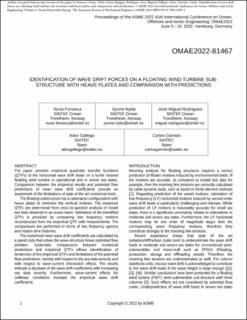| dc.contributor.author | Fonseca, Nuno | |
| dc.contributor.author | Nybø, Synne Hoggen | |
| dc.contributor.author | Rodrigues, José Miguel | |
| dc.contributor.author | Gallego, Aitor | |
| dc.contributor.author | Garrido, Carlos | |
| dc.date.accessioned | 2023-06-27T12:33:30Z | |
| dc.date.available | 2023-06-27T12:33:30Z | |
| dc.date.created | 2023-03-07T10:53:44Z | |
| dc.date.issued | 2022 | |
| dc.identifier.isbn | 978-0-7918-8593-2 | |
| dc.identifier.issn | 1523-651X | |
| dc.identifier.uri | https://hdl.handle.net/11250/3073503 | |
| dc.description.abstract | The paper presents empirical quadratic transfer functions (QTFs) of the horizontal wave drift loads on a turret moored floating wind turbine in operational and in severe sea states. Comparison between the empirical results and potential flow predictions of mean wave drift coefficients provide an assessment of the limitations of state of the art numerical tools. The floating substructure has a catamaran configuration with heave plates to minimize the vertical motions. The empirical QTFs are determined from cross bi-spectral analysis of model test data obtained in an ocean basin. Validation of the identified QTFs is provided by comparing low frequency motions reconstructed from the empirical QTF with measurements. The comparisons are performed in terms of low frequency spectra and motion time histories. The numerical mean wave drift coefficients are calculated by a panel code that solves the wave-structure linear potential flow problem. Systematic comparisons between numerical predictions and empirical QTFs allows identification of tendencies of the empirical QTFs and limitations of the potential flow predictions, namely with respect to the sea state severity and with respect to wave-current interaction effects. The results indicate a decrease of the wave drift coefficients with increasing sea state severity. Furthermore, wave-current effects for collinear conditions increase the empirical wave drift coefficients. | en_US |
| dc.language.iso | eng | en_US |
| dc.publisher | ASME | en_US |
| dc.relation.ispartof | ASME 2022 41st International Conference on Ocean, Offshore and Arctic Engineering Volume 8: Ocean Renewable Energy | |
| dc.subject | Floating wind turbines | en_US |
| dc.subject | Wave drift forces | en_US |
| dc.subject | Wave drift | en_US |
| dc.title | Identification of wave drift forces on a floating wind turbine sub-structure with heave plates and comparison with predictions | en_US |
| dc.title.alternative | Identification of wave drift forces on a floating wind turbine sub-structure with heave plates and comparison with predictions | en_US |
| dc.type | Chapter | en_US |
| dc.type | Peer reviewed | en_US |
| dc.description.version | acceptedVersion | en_US |
| dc.rights.holder | Copyright © 2022 by ASME | en_US |
| dc.source.journal | International Conference on Offshore Mechanics and Arctic Engineering (OMAE) [proceedings] | en_US |
| dc.identifier.cristin | 2131850 | |
| cristin.ispublished | true | |
| cristin.fulltext | postprint | |
| cristin.qualitycode | 1 | |
